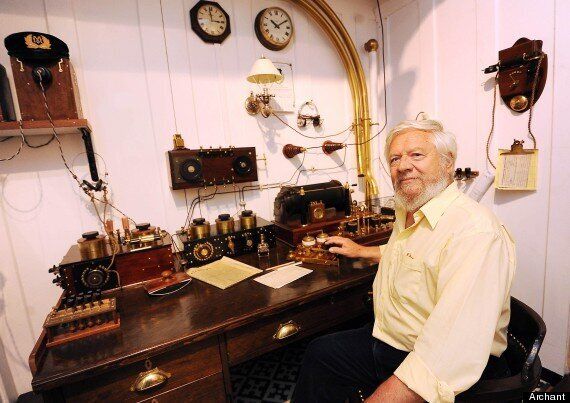The Titanic has been poignantly brought back to life – more than 100 years after she sank in one of the greatest stories of all time.
The iconic White Star liner plunged to the bottom of the North Atlantic after striking an iceberg on its maiden voyage on April 14, 1912 – with the loss of 1502 passengers and crew.
The Marconi wireless room, which was used to send distress signals during the terrifying sea tragedy, has now gone on show at Swaffham Museum, Norfolk, for three months.

Ted Sinclair with his Titanic restoration
Retired lorry driver Ted Sinclair, 71, of nearby Beachamwell, has spent four years meticulously creating a perfect copy of the early 20th century maritime communications centre.
The huge Titanic enthusiast said: “It has been a real labour of love because the parts are wildly expensive.
“Where possible I have used original pieces from the time.”
Mr Sinclair bought most of the items for his incredibly lifelike replica from eBay – including a silver plated brass lamp dredged up from the seabed near the doomed supership.
Some 12 copies of a brass handle with an original White Star Line design were also made for the desk.
James Cartland and Sons, which had a large foundry in Birmingham, made the original handle and James Cartland was the grandfather of late popular author Barbara Cartland.
At the time of the catastrophe the cutting edge equipment in the wireless room, which sent Marconigrams, was state-of-the-art and was mostly made from wood or brass.
“While the system had been used for eight years, the shipping companies didn’t take it that seriously to exchange information about icebergs.
“It was not part of their safety system,” said Mr Sinclair.
“What they liked about it was the well-off clients could send messages from the ship to the shore.
“It would be quite pricey.”
Sending a message from the Titanic’s wireless room on the boat deck cost 12/6d for the first 10 words and 9d for each word after that.
At today’s prices, an average Marconigram would cost a staggering £50 to despatch.
Mr Sinclair’s brilliantly faithful display was inspired by a photograph taken by first class passenger the Rev Frank Browne.
Mr Browne got on at Southampton before disembarking at Queenstown, Ireland, now called Cobh.
The Jesuit priest was staying on ‘A’ deck and took pictures around the ship, including the wireless room at 10.10am, on April 12.
Senior ship radio operator Jack Phillips, 25, and Harold Bride, 22, the junior radio operator, desperately sent out SoS pleas for help from the wireless room as Titanic went down.
Mr Phillips was killed but Mr Bride miraculously survived.
Titanic’s sister ship, the Olympic, responded, but was too far away and the SS Carpathia, a passenger steamship, arrived four hours after disaster struck.
Mr Sinclair said terrified radio operators fired off more than 20 signals as the “unsinkable” 46,000 ton giant foundered south of Newfoundland.
A back-up system which ran from batteries was used after the power supply failed 30 minutes before the Titanic sank.
Thrilled Sian Hogarth, heritage development officer for Swaffham Museum, said: “I think the display is amazing.
“It is a huge undertaking because Ted has got it so right and I admire him for doing that.”
She added: “It is a lovely tribute to people who were lost on the Titanic and Ted’s encyclopaedic knowledge
compliments it.”
The wireless room featured in the Titanic exhibition at the Forum in Norwich in April to mark the Forncett Industrial Steam Museum disaster’s centenary and briefly at Forncett Industrial Steam Museum, Norfolk.
Mr Sinclair, who has been bewitched by the Titanic since he was a schoolboy, said: “The disaster was a bit of a turning point.
“Afterwards, the powers that be brought in regulations for equipping ships with radios.”